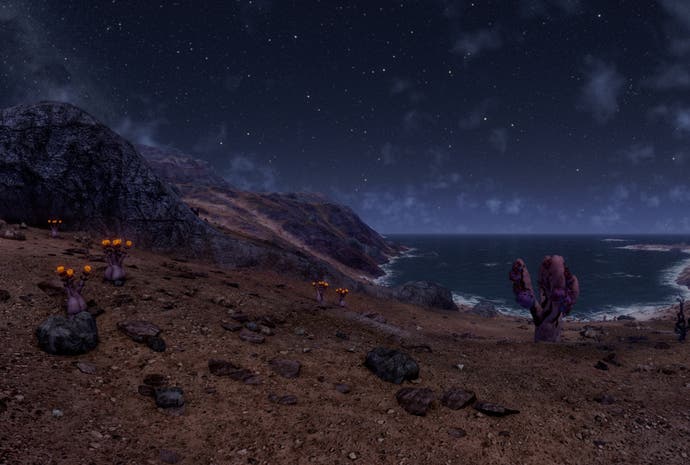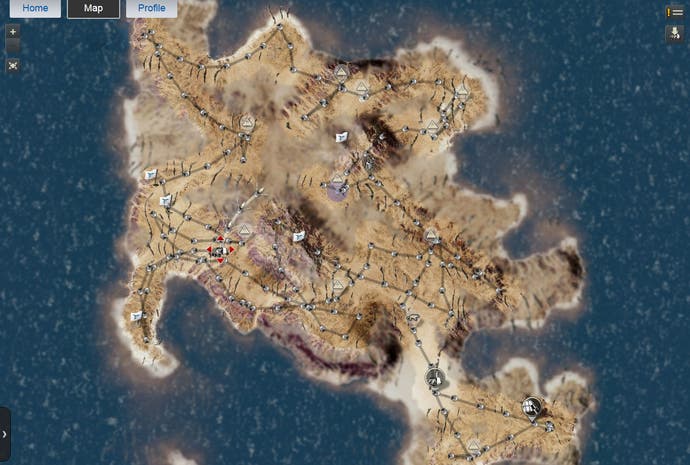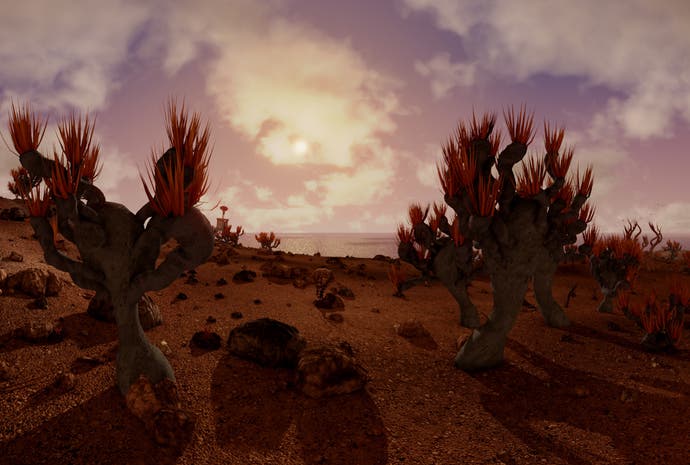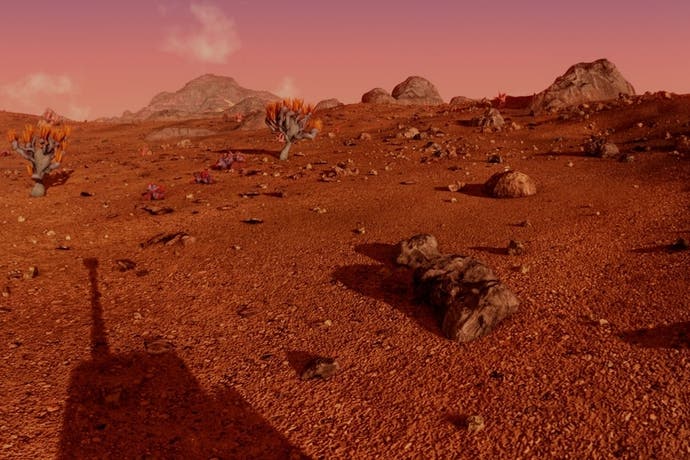Rovers Return: reinventing the ARG with Extrasolar
Explore an entire alien ecosystem from your browser window.
I have a confession to make. I've found a free-to-play game with a cooldown system that I love. Usually, these artificial barriers to progress make me climb the walls in despair. In Extrasolar, a narrative browser game from Lazy 8 Studios, I actively look forward to being made to wait for the next bit of gameplay.
The difference is context. In Extrasolar, you sign up with XRI, a private space agency exploring an alien world, Epsilon Prime. You're not playing as a character, you're you. And you're not on Epsilon Prime, you're a volunteer controlling a robotic rover on the planet's surface from your home PC. Accessing XRI's systems via your web browser, you click-and-drag on a map of the small island that is your designated research area, and tell your rover where to go next. You'll have missions to complete, directing you to certain spots or in search of certain samples, but once you're past a short introductory section you have the freedom to tackle tasks in whatever order you want, or simply explore under your own steam. Once a waypoint has been set, the rover trundles off, takes a photo of the map location you sent it to, and you receive the image.
Just as this is a game that comes to you via your inbox and browser and is experienced in real life, so too does the whole experience play out in real time. Epsilon Prime has its own lunar cycle, your rover has limited range and speed, and so if you want a photo in the daylight - or in the dark - you may need to tell it to wait for the appropriate time. And you'll have to wait as well.
Once a photo arrives back, rendered in the cloud with almost photo-real precision, your job is to study it and tag up to three points of interest, which then get analysed by XRI. The more things you find, the more the database on Epsilon Prime fills up. It's an ingenious concept, and one that turns the countdown mechanic into a period of anticipation, entirely justified by the narrative, rather than a crude interruption against your will.

For Rob Jagnow, Extrasolar's producer, director and (in video segments) star, the wait-and-see element everything to do with the experience he wanted to share. Armed with a PhD in Computer Science with a specialism in "highly realistic processor-intensive computer graphics", Rob drifted into game design almost by accident, after a short-term stint working for an indie developer blossomed into a passion for the medium and its storytelling potential.
Having spent two summers working at Pixar, where he'd assumed he'd return to work in movies, Rob instead set up his own small game development studio in San Francisco. Lazy 8's first game, the stylish steampunk puzzler Cogs, went on to be a finalist at IGF and won the $100,000 grand prize at the Indie Games Challenge. That windfall opened the doors for Lazy 8 to try something "crazy", as Rob puts it.
"We were tossing around a bunch of ideas, me and Brendan, the artist, and I was thinking that what I really want to do is bring high-quality rendering to a casual audience," Rob tells me via Skype. "I thought if I wanted to bring that to the web, I could theoretically render images in the cloud, but you can only do one at a time. So what would the experience be, what game can you create around that experience? And immediately it was like, 'Oh, space exploration!' That is exactly how the Mars rovers work. It takes a long time to prepare one photo, a long time to get it back to us, and that was the inception."
Although the game costs nothing to play, you can sign up for higher tiers of XRI membership. This reduces the time it takes for the rover to move and return a photo from four hours to just one, and also gives you unlimited access to special photographic features such as panoramic shots and infra-red. What you're not doing is paying to top up constantly depleting energy reserves - a one-off payment unlocks the extra content for good. Paying players also get more missions, and the chance to send recruitment invitations to friends.
It's at this initial entry point that you get a sense of the sort of game Extrasolar is trying to be. I won't spoil it, but the game's first response to your signing up is quite brilliant, and establishes the way it will overlap with real life beautifully. It's also something that is likely to push some players away, if they're not paying attention.

"The first thing we do is reject you," Rob admits. So how many players does he lose through this opening gambit? "We worked really hard to get that number down, and it's now about 10 per cent which isn't crazy," he says. "It's funny. If we were a major games studio and we told the high level executives 'Yeah, we have a thing at the start of the game and we're going to lose 10 percent of the players' they'd say 'No way, you can't do that!'. We have the freedom to do that, and we understand that for the people who get through that process, there are a couple of things. One, they have a better idea of what they're getting into. It creates expectations. Two, they're really invested. It's an exciting moment."
It's also a moment that establishes Extrasolar's deeper narrative. This isn't merely an exploration game, and there's an ongoing story the unfolds through emails, video messages and audio conversations between the scientists and a mysterious hacker known as kryptex81. You find yourself finding passwords, hacking servers and passing classified PDFs to informants as the murky truth behind XRI slowly reveals itself.
"If you've played ARGs you'll know that it's ARG-inspired, but it also violates a lot of the tenets of what an ARG usually is"
Rob Jagnow
It's here that Extrasolar deviates most sharply from the ARG model that most people know. Rob explains that Extrasolar was originally designed to be played by a large community of players, all working together to solve puzzles and cyphers at the same time, but they found that it undermined the conspiracy storyline.
The fantasy of being a single person caught up in the intrigue is simply more compelling than the anonymous comfort of being one of a crowd of players. That means more immersion for the player, but less virality for Lazy 8. "If you've played ARGs you'll know that it's ARG-inspired, but it also violates a lot of the tenets of what an ARG usually is," says Rob. "We know that this approach is risky. We made the decision to be true to the story, and anything that compromises the fiction, we're going to cut out."
What the game does allow is for individual photos to be shared via Facebook and Twitter, but only if there's nothing confidential in them. "We 'classify' a lot of photos on the server," Rob explains. "If the renderer 'sees' that there's a spoiler in this image then it classifies that and prevents sharing."

It's not the most robust defence against spoiler leaks, however, and Lazy 8 isn't getting too hung up on the idea of people sharing information from later in the story. In fact, it seems they almost want that level of excitement. "We know that people are going to take screenshots and work around that, and that's totally fine," Rob accepts. "I don't think spoilers harm a lot of people's experience but we make it a little harder to do that kind of thing. And we know that people are going to talk about it behind the scenes. We hope that they do. We really hope that people enjoy the surprise of getting into the game that they share that with their friends. Have we made the right decisions? I don't know. But we've really enjoyed it, and staying true to the fiction has been very rewarding from a design standpoint."
Even though the game is fiction, it nevertheless keeps one foot firmly in reality thanks to the character of Dr. Jane van Susteren, the XRI biologist who contacts you via excited emails to share her theories on the lifeforms you discover. Or rather, she's not a character at all.
"Jane van Susteren is a real person," says Rob. "She's an actual biologist who lives in San Francisco and she's a friend of Brendan, the artist. We pulled her in, and were showing her images. She was really excited about this, so we brought her on as a paid consultant. We would show her images and say 'If this was what you saw from an alien planet, what would you want to know? What experiments would you want to run? What assumptions would you have' And she came up with all this content. What she wrote became the core for the science missions, which are very much inspired by real biology."
It's this depth of research, coupled with a fine balancing act between pure pulp science fiction and grounded thriller, that makes Extrasolar such an intriguing curiosity. It's devilishly hard to categorise, but very quickly becomes incredibly compelling, serving up its story in bite-sized chunks several times per day. All told, the whole thing probably doesn't last more than a few hours, but by intruding into your day to day life piece by piece, it ends up feeling more epic and enthralling than if it spooled off a DVD in an eight-hour campaign.
According to Rob, it takes most players around one month to play through the story. The version that is online right now only launched on February 18th after a long beta trial process, but plans are already in place to continue the experience, with the current storyline referred to as the first of potentially three TV-style seasons.
As for me, I'm still trundling along on the surface of Epsilon Prime, trying to document as much of the other-worldly wildlife as I can before the conspiracy overtakes me. No rush.

